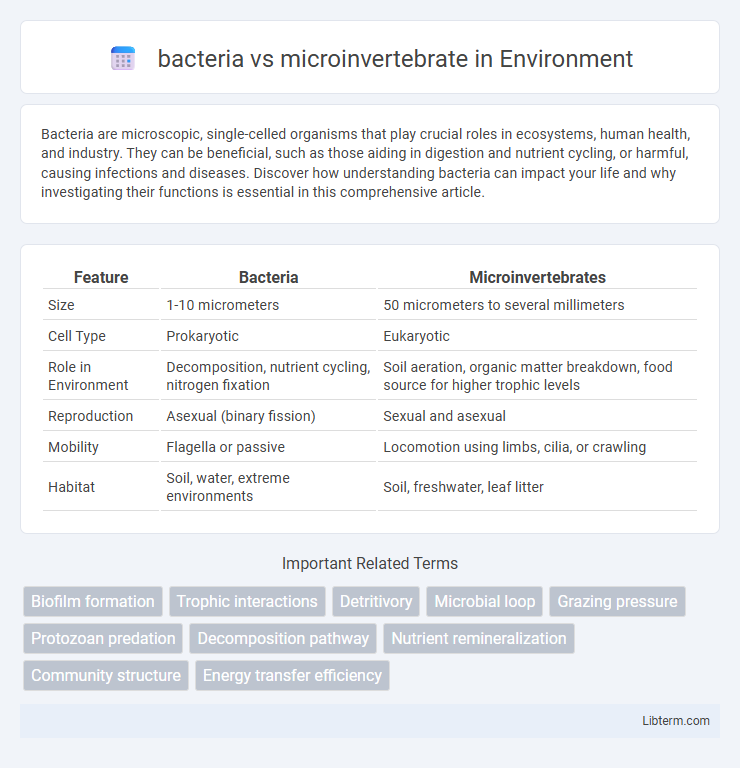Bacteria are microscopic, single-celled organisms that play crucial roles in ecosystems, human health, and industry. They can be beneficial, such as those aiding in digestion and nutrient cycling, or harmful, causing infections and diseases. Discover how understanding bacteria can impact your life and why investigating their functions is essential in this comprehensive article.
Table of Comparison
| Feature | Bacteria | Microinvertebrates |
|---|---|---|
| Size | 1-10 micrometers | 50 micrometers to several millimeters |
| Cell Type | Prokaryotic | Eukaryotic |
| Role in Environment | Decomposition, nutrient cycling, nitrogen fixation | Soil aeration, organic matter breakdown, food source for higher trophic levels |
| Reproduction | Asexual (binary fission) | Sexual and asexual |
| Mobility | Flagella or passive | Locomotion using limbs, cilia, or crawling |
| Habitat | Soil, water, extreme environments | Soil, freshwater, leaf litter |
Introduction to Bacteria and Microinvertebrates
Bacteria are microscopic, single-celled organisms that play crucial roles in nutrient cycling, decomposition, and disease processes in various ecosystems. Microinvertebrates, such as nematodes, rotifers, and tardigrades, are small multicellular animals that contribute to soil health, organic matter breakdown, and serve as bioindicators in environmental monitoring. Understanding the distinct biological functions and ecological roles of bacteria and microinvertebrates is essential for studying microbial communities and soil biodiversity.
Defining Characteristics: Bacteria vs Microinvertebrates
Bacteria are single-celled prokaryotes characterized by their lack of membrane-bound organelles and their ability to reproduce primarily through binary fission. Microinvertebrates, in contrast, are multicellular eukaryotic organisms with differentiated tissues, often exhibiting complex organ systems and locomotion abilities. While bacteria play crucial roles in nutrient cycling through biochemical processes, microinvertebrates contribute to ecosystem dynamics by predation, decomposition, and serving as bioindicators in aquatic and soil environments.
Cellular Structure and Organization
Bacteria are prokaryotic microorganisms characterized by a simple cellular structure lacking a nucleus and membrane-bound organelles, with genetic material located in a nucleoid region. Microinvertebrates are multicellular eukaryotic organisms with complex cellular organization, including a true nucleus, membrane-bound organelles, and differentiated tissues. The cellular complexity in microinvertebrates enables higher functionality and specialization compared to the single-celled and structurally simpler bacteria.
Habitat and Environmental Roles
Bacteria thrive in diverse habitats including soil, water, and extreme environments, playing crucial roles in nutrient cycling, decomposition, and nitrogen fixation. Microinvertebrates inhabit aquatic ecosystems, soil, and leaf litter, contributing to organic matter breakdown and serving as a key link in food webs by preying on microorganisms and facilitating nutrient transfer. Both groups are essential for maintaining ecosystem stability, with bacteria driving chemical processes and microinvertebrates enhancing biological interactions.
Reproduction and Life Cycles
Bacteria reproduce primarily through binary fission, a rapid asexual process enabling exponential population growth under favorable conditions. Microinvertebrates exhibit diverse reproductive strategies ranging from sexual reproduction involving complex life cycles with multiple developmental stages to parthenogenesis in some species. The life cycles of microinvertebrates often include distinct larval and adult phases, contrasting with the simpler, continuous division cycle of bacteria.
Nutritional Methods and Metabolism
Bacteria primarily obtain nutrients through absorption and chemosynthesis, utilizing diverse metabolic pathways such as aerobic and anaerobic respiration, fermentation, and nitrogen fixation. Microinvertebrates consume organic material and microorganisms, relying on heterotrophic metabolism to break down complex compounds for energy. The metabolic flexibility of bacteria supports nutrient cycling, while microinvertebrates contribute to energy transfer within ecosystems.
Ecological Interactions and Significance
Bacteria and microinvertebrates exhibit complex ecological interactions, where bacteria serve as primary decomposers breaking down organic matter, while microinvertebrates regulate bacterial populations through predation. This dynamic influences nutrient cycling and energy flow in ecosystems, driving soil fertility and water quality. Both groups contribute significantly to ecosystem resilience and biodiversity by sustaining microbial food webs and facilitating biogeochemical processes.
Human and Environmental Impact
Bacteria significantly influence human health by causing diseases and driving antibiotic resistance while playing essential roles in environmental nutrient cycling and waste decomposition. Microinvertebrates, such as nematodes and rotifers, contribute to soil and aquatic ecosystems by regulating microbial populations and enhancing organic matter breakdown, thus supporting ecosystem stability. The balance between bacteria and microinvertebrates directly impacts environmental quality and human well-being through biogeochemical processes and pathogen control.
Research and Identification Techniques
Research on bacteria employs methods like polymerase chain reaction (PCR), fluorescence in situ hybridization (FISH), and metagenomic sequencing to accurately identify microbial species and assess their functions in ecosystems. Microinvertebrate identification relies heavily on morphological analysis using light and electron microscopy, complemented by DNA barcoding techniques to resolve species-level taxonomy. Integrating molecular tools with traditional microscopy enhances precision in characterizing biodiversity and ecological roles of both bacteria and microinvertebrates in environmental studies.
Conclusion: Key Differences and Similarities
Bacteria are unicellular microorganisms essential for nutrient cycling and decomposition, while microinvertebrates are tiny multicellular animals involved in soil aeration and organic matter breakdown. Both play crucial roles in ecosystem functioning, but bacteria reproduce rapidly through binary fission, whereas microinvertebrates reproduce sexually or asexually and possess complex body structures. Despite their differences, they share a symbiotic relationship in maintaining soil health and nutrient dynamics.
bacteria Infographic

 libterm.com
libterm.com